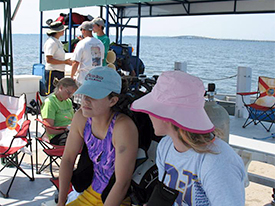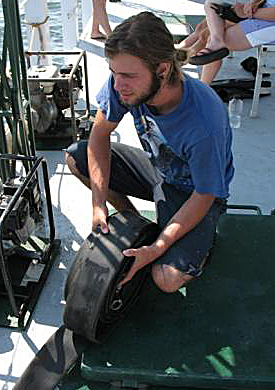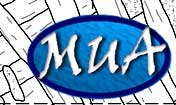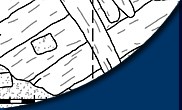
Emanuel Point II
9-13 June 2008
By Irina Franklin
This week students transitioned their research focus from the 19th century to the 16th century. Field school operations were held in Pensacola Bay on the second vessel found from Tristan de Luna’s 1559 colonization attempt. The second vessel, Emanuel Point II (EPII), will be a major focus for this summer’s field school. Please look at our links under additional resources on this website to learn more about the historical and archaeological background of both vessels, EPI and EPII.

Field school crew enjoying the new barge.
After months of restoration and repair work, the UWF Barge is back in the water ready for another field session. The barge will be used as a diving platform for operations on EPII this summer. Due to the effects of the harsh saltwater environment, the barge needed to be taken out of the water and revamped. A crane moved the barge in early spring to UWF’s Marine Services Center (MSC). Staff from MSC sand blasted and needle gunned rust away, welded new steal holds, fabricated a dive gear rack, installed a new awning, added wooden docking panels, and repainted the entire barge. Throughout this whole process students and faculty associated with UWF’s Archaeology Institute worked side-by-side with MSC staff.

Amanda preparing for her dive.
As with any field that has a heavy reliance on equipment, technology, and Mother Nature, those in the field of maritime archaeology must be flexible, resourceful, and patient. This week students were introduced to the “real world” of maritime archaeology. A world where there are problems with boats, difficulty with equipment, and the constant threat of thunderstorms. Throughout the week the students overcame and adapted to each situation.
When we were not fleeing from ensuing thunderstorms, the field school started excavation on EPII. Two new 1x1 meter units were triangulated into our grid system. One unit was placed in towards the north end of the site looking for the possible limits of the bow, and one unit was placed in the south looking to delineate the stern section of the vessel. Team 1 (Jake, Amanda, & Chris) and Team 3 (Scott, Jenn, & Eric) were assigned the north unit and Team 2 (Ashley, Brian, & Bryce) and Team 4 (Colleen, Hans, & Lynne) were assigned the south unit.

Brian unrolling a dredge hose for a diver.
Every team had practice in setting up the dredge, excavating, and breaking down the dredge over the course of the week. Each unit is excavated in 10 cm levels to maintain control and provenience. Due to the weather, we were not able to get below 20 cm in either unit. By next week, we should begin to expose ballast stones and eventually the ship’s structure.
On Friday we were honored with the presence of Santiago Cabanas, Consul General of Spain, and Maria Davis, Spain's honorary Vice Consul, on the UWF barge. The dignitaries, local media, Pensacola citizens, along side UWF faculty and maritime field school students, participated in a wreath laying ceremony over the shipwreck site to commemorate the 450th anniversary of Tristan de Luna’s colonization attempt. With the support of Spain and the local public, we look forward to a successful field school season.
Wreath laying ceremony over the shipwreck site on 13 June 2008 to commemorate the 450th anniversary of Tristan de Luna’s colonization attempt. The attending dignitaries included Santiago Cabanas, Consul General of Spain, and Maria Davis, Spain's honorary Vice Consul.
This week also introduced the field school students to various aspects of public archaeology. By the end of the summer students will have received plenty of experience talking to the media, local public and distinguished guests. We will continue excavations on EPII next week, and hopefully the weather will be on our side and we can open up more units and begin to answer more of our research questions.
Please feel free to contact us if you have any questions or concerns at: mua@keimaps.com.
Return to Project Journal home page.

